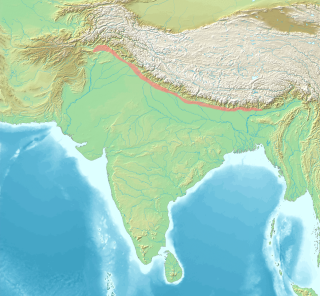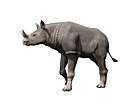
Merychippus is an extinct proto-horse of the family Equidae that was endemic to North America during the Miocene, 15.97–5.33 million years ago. It had three toes on each foot and is the first horse known to have grazed.

The Sivalik Hills, also known as Churia Hills, are a mountain range of the outer Himalayas. The literal translation of "Sivalik" is 'tresses of Shiva'. The hills are known for their numerous fossils, and is also home to the Soanian Middle Paleolithic archaeological culture.

Hipparion is an extinct genus of three-toed, medium-sized equine belonging to the extinct tribe Hipparionini, who lived about 10-5 million years ago. While the genus formerly included most hipparionines, the genus is now more narrowly defined as hipparionines from Eurasia spanning the Late Miocene. Hipparion was a mixed-feeder who ate mostly grass, and lived in the savannah biome. Hipparion evolved from Cormohipparion, and went extinct due to environmental changes like cooling climates and decreasing atmospheric carbon dioxide levels.

Rhamphosuchus is an extinct genus of gavialid crocodylians. It lived during the Pliocene and its fossils have been found in two regions; the Siwalik Hills of Pakistan and India as well as the Sindh region of Pakistan. Its type species is Rhamphosuchus crassidens, which is only known from incomplete sets of fossils, mostly teeth and skulls. Four species traditionally placed in the genus Gavialis may be included as well.

Barbourofelidae is an extinct family of carnivorans of the suborder Feliformia, sometimes known as false saber-toothed cats, that lived in North America, Eurasia and Africa during the Miocene epoch and existed for about 7.9 million years. Thought to be an independent lineage from the Nimravidae and Machairodontinae, which had all attained elongated canines, recent research argues that it may be a subfamily of the Nimravidae, extending its biochronological range into the Miocene, although this issue is not yet fully resolved.

The evolution of the horse, a mammal of the family Equidae, occurred over a geologic time scale of 50 million years, transforming the small, dog-sized, forest-dwelling Eohippus into the modern horse. Paleozoologists have been able to piece together a more complete outline of the evolutionary lineage of the modern horse than of any other animal. Much of this evolution took place in North America, where horses originated but became extinct about 10,000 years ago, before being reintroduced in the 15th century.

Indopithecus giganteus is an extinct species of large ape that lived in the late Miocene of the Siwalik Hills in northern India. Although frequently assigned to the more well-known genus Gigantopithecus, recent authors consider it to be a distinct genus in its own right.

Protohippus is an extinct three-toed genus of horse. It was roughly the size of a modern donkey. Fossil evidence suggests that it lived during the Late Miocene, from about 13.6 Ma to 5.3 Ma.

Pseudhipparion is an extinct genus of three-toed horse endemic to North America during the Miocene. They were herding animals whose diet consisted of C3 plants. Fossils found in Georgia and Florida indicate that it was a lightweight horse, weighing up to 90 pounds. In 2005, fossils were unearthed in Oklahoma. Seven species of Pseudhipparion are known from the fossil record which were very small, following the trend of Bergmann's rule.

Nannippus is an extinct genus of three-toed horse endemic to North America during the Miocene through Pleistocene, about 13.3—1.8 million years ago (Mya), living around 11.5 million years. This ancient species of three-toed horse grew up to 3.5 feet and weighed between 165 pounds to 199 pounds, which was around the same size as a domestic sheep.

Cormohipparion is an extinct genus of horse belonging to the tribe Hipparionini that lived in North America during the late Miocene to Pliocene. They grew up to 3 feet long.
Paleontology or palaeontology is the study of prehistoric life forms on Earth through the examination of plant and animal fossils. This includes the study of body fossils, tracks (ichnites), burrows, cast-off parts, fossilised feces (coprolites), palynomorphs and chemical residues. Because humans have encountered fossils for millennia, paleontology has a long history both before and after becoming formalized as a science. This article records significant discoveries and events related to paleontology that occurred or were published in the year 1969.

Hippotherium is an extinct genus of horse that lived in during the Miocene through Pliocene ~13.65—6.7 Mya, existing for 6.95 million years.
Indraloris is a fossil primate from the Miocene of India and Pakistan in the family Sivaladapidae. Two species are now recognized: I. himalayensis from Haritalyangar, India and I. kamlialensis from the Pothohar Plateau, Pakistan. Other material from the Potwar Plateau may represent an additional, unnamed species. Body mass estimates range from about 2 kg (4.4 lb) for the smaller I. kamlialensis to over 4 kg (8.8 lb) for the larger I. himalayensis.

Cremohipparion is an extinct genus of horse living in Eurasia and Africa during the Miocene through Pliocene.
The Alachua Formation is a Miocene geologic formation in Florida. The claystones, sandstones and phosphorites of the formation preserve many fossils of mammals, birds, reptiles and fish, among others megalodon.
Sivaladapis is a genus of adapiform primate that lived in Asia during the middle Miocene.
Rhinoclemmys panamaensis is an extinct species of turtle belonging to the genus Rhinoclemmys of the family Geoemydidae known from the early to middle Miocene (Hemingfordian) Cucaracha Formation of the Panama Basin of central Panama.
Gaindatherium is an extinct genus of rhinocerotid that lived in Asia during the Miocene. It is mainly known from the Siwalik Hills in Pakistan, though its fossils have been found as far west as the Negev desert.
Vishnuictis is an extinct genus of viverrid known from the Middle Miocene to Pleistocene of India, Pakistan, China, and Kenya. It is named after Vishnu, one of the primary Hindu deities.
























